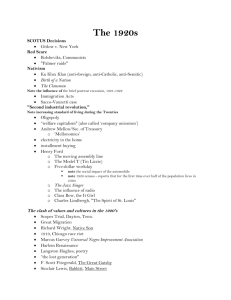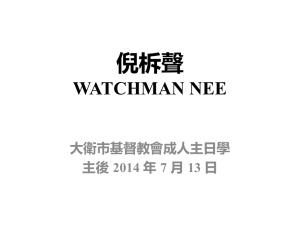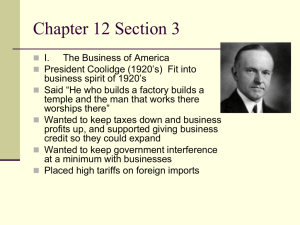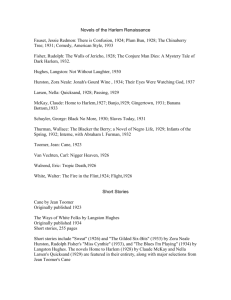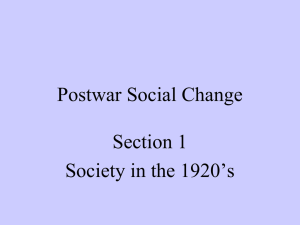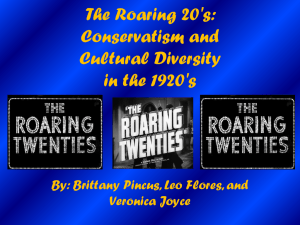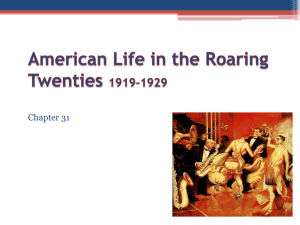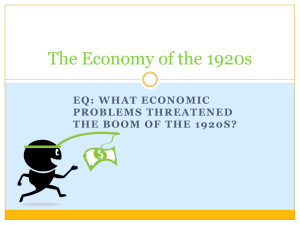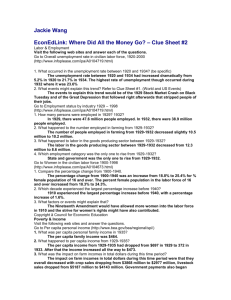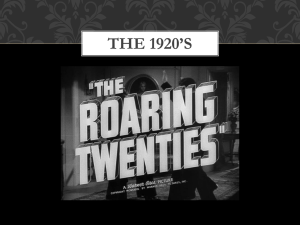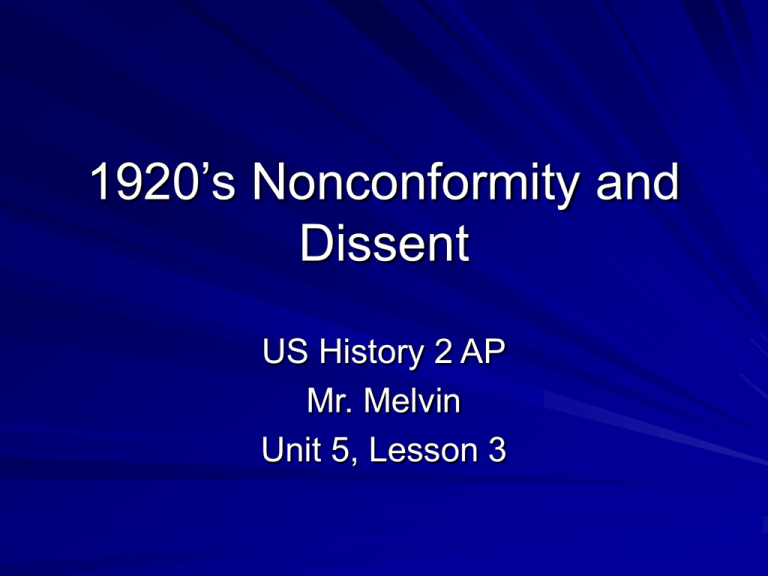
1920’s Nonconformity and
Dissent
US History 2 AP
Mr. Melvin
Unit 5, Lesson 3
Nonconformists
Some Americans repelled by materialism
of 20’s
Felt alienated by business culture
– Some turned to Communism (Small)
– Others: Seek pleasures of present and live
through self-expression
– Turned to this rather than help the public get
better
Nonconformists
Most were young
No more rebellious than past generations
Were much more impatient with the
present standards of conduct
Jazz Music
Major symbol of protest
Developed by Black musicians
Known for spontaneity, sensuality, rhythm,
and sensual dancing
Previous music and dance: very
coordinated, rote, and organized
Very White!
Jazz Music
Started in New
Orleans and began to
spread to Northern
Cities
Famous musicians:
Louis Armstrong
Scott Joplin
“Buddy” Bolden
“King” Oliver
Jelly Roll Morton
Armstrong
Morton
Changes in Family Structure
Differences in Urban and Rural Family
Structures:
Urban: nuclear family (husband, wife, kid)
Rural: kinship family (nuclear family +
many other relatives)
Impersonality of city life led to many other
changes in social family standing
Women
Began to demand easier divorces and
equal social rights
Increasingly involved with cigarettes,
whiskey, sexual satisfaction (in and out of
marriage)
Dress changed amongst city women
“Flappers”
Women
Women
Premarital sex rose in
1920’s
Younger generation
see it as rebelling
against current neopuritanical culture
Assisted by Margaret
Sanger and birth
control movement
(release from “sexual
prejudice”)
Sex
People beginning to study
sex and human nature
Freud: Neurotic behavior
and symptoms connected
to sexual origin
Didn’t advocate
promiscuity!
Americans took it that
way, however
“The Lost Generation”
1920’s writers turned backs to progress
and cultural growth
Detested business culture of America
Many fled abroad or went into reclusion
All works revealed:
– Alienation from society
– Protest to how US culture has changed
“Lost Generation”
Sinclair Lewis – Main
Street (1920) &
Babbit (1922)
Satirical Symbols of
American Life
“Our Ideal Citizen—I picture him first and foremost
as being busier than a bird-dog, not wasting a lot of
good time in day-dreaming or going to sassiety teas
or kicking about things that are none of his
business, but putting the zip into some store or
profession or art. At night he lights up a good cigar,
and climbs into the little old ‘bus, and maybe cusses
the carburetor, and shoots out home.”
“Lost Generation”
Sherwood Anderson – Winesburg, Ohio
(1919)
Abandoned business career after mental
breakdown
Autobiographical novel about business
alienation and cruelty
“Lost Generation”
Ernest Hemmingway – The
Sun Also Rises (1926) & A
Farewell to Arms (1929)
Revulsion of 19th century
glorification of war
“If people bring so much courage to
this world the world has to kill them to
break them, so of course it kills them.
The world breaks every one and
afterward many are strong at the
broken places. But those that will not
break it kills. It kills the very good and
the very gentle and the very brave
impartially. If you are none of these
you can be sure it will kill you too but
there will be no special hurry.”
“Lost Generation”
William Faulkner – The Sound and the
Fury (1929)
Exposed tension between self and society
– set in Deep South (racism)
T.S Eliot (poet) – Love Song of J.Alfred
Prufrock (1917) & The Wasteland (1922)
Weary symbol of modern man
Fragmentation & despair
The Harlem Renaissance
Group of AfricanAmerican artists and
authors that also
depicted the issues
with society
Race, injustice,
discrimination
Langston Hughes,
Countee Cullen,
James Weldon
Johnson
Why Alienated?
Artists turned away from US society not
because of its inequities, but because of
its superficial accomplishments.
– Different from progressives
– Sought private escapes and benefits
– Society denied some great minds!
Alienation + Anti-Democracy
Some artists cast off democracy as well
Van Wyck Brooks – “The Ordeal of Mark
Twain (1920)
– Called Gilded Age “A Horde Life”
T.S. Eliot – scorned democracy until he
found religion
H.L. Mencken – ridiculed KKK, Prohibition,
and American people
– Considered them “an ignorant mob”
Neo-Progressivism
Some critics didn’t
alienate themselves
John Dewey –
experimentation in
education for selfless
citizenship
– Public rather than
private planning
Neo-Progressivism
Charles Beard –
economic change
– Social engineering,
national planning ,
organize and advance
science and
technology for general
good
Neo-Progressivism
Charles Commons – social insurance
Irving Fisher – government needs to
mange money supply to achieve desirable
social agenda for all
Foster & Catchings – to avoid future
depression, government should engage in
public spending when private investment
fails
1920’s Feminism
Women not happy with
just suffrage
Interest groups wanted
Equal Rights Amendment
passed (constitutional
guarantee)
League of Women Voters
– Attempted to unite women
– Educate them on issues
– Unite towards attaining
more rights
– Not very successful;
women didn’t vote as
whole
Coolidge Domestic Policy
1926 – Mellon wanted to cut taxes on rich
even more
– Nobody could find argument against it –
Economy doing so well!
Revenue Act of 1926 – cut in half estate
tax and income taxes for highest bracket
1928 – Mellon further cut taxes on
corporations
Utility Companies
Private utility companies saw huge gains during
1920’s
Able to set up monopolies through formation of
holding companies
1929 – 10 companies owned ¾ of power
companies in nation
Kept electricity costs high and manipulated
prices to keep stocks soaring
Were able to beat back public demands for
reform
Aid to Farmers?
Farmers wanted from government:
– High domestic prices for goods and low
foreign prices
– Buying of farmers excess goods and then sell
them for a profit overseas
– Government would make money by charging
farmers a tax to sell their products
– McNary-Haughen Act (1924) – rejected by
Coolidge
Aid to Farmers?
Coolidge rejected revised bills again in
1927 & 1928 because:
Create a clumsy bureaucracy
Delegate taxing power away from Congress to
administrators of program
Would involve government in price fixing
Create artificial prices and encourage farmers to
overproduce
Foreign countries would do the same to America
Dump their surpluses into our market
National Debate
By end of Coolidge’s 2nd “term”, national
debate emerged:
Should government:
– Be the tool of industry and wealthy?
– OR
– Build society that obtains fair share for
everyone?
1928 Election
Coolidge decides not to
run for his 2nd full term
Republicans choose
Herbert Hoover
– Platform:
Success in decade
because of Republicans
Prohibition
Pro-Business and AntiLabor
Warned farmers of “evil” of
getting involved in industry
American System and
Laissez-Faire
“US” is near to triumphing
over poverty forever!
1928 Election
Democrats chose Al
Smith
– Platform:
Endorsed tariff
McNary-Haughen Bills
Public ownership of
power, etc
Had record of efficiency
that rivaled Hoover’s
1928 Election
Campaign opened up old wounds from
1924
Smith and campaign manager both
Catholic and “wets”
Rural America became very suspicious of
both
Smith spent much time saying religion not
big deal
1928 Election
Prosperity and a little bigotry prevailed
444 EV – 87 EV
Trends for Democrats
– Won majority in 12 largest cities
– Cut into Republican farming areas in West
– Democrats now further convinced to party
unity and need for social reconstruction


